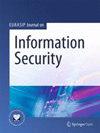可信数据共享的访问控制
IF 2.5
Q2 COMPUTER SCIENCE, INFORMATION SYSTEMS
引用次数: 0
摘要
在设想的 6G 环境中,数据共享预计将变得越来越普遍,这将催生数字市场,促进各组织之间在收集、共享和处理分析数据方面的合作。这些市场充当数据生产者和消费者之间的连接器,支持多租户场景,实现组织内外无缝、安全的数据共享。鉴于 6G 网络有望实现超低延迟、增强连接性和海量数据吞吐量,因此必须建立强大的数据访问控制机制。这些机制可确保实体间的安全和信任,尤其是在多个组织共享基础设施和数据资源的多租户环境中。在本文中,我们为诺基亚贝尔实验室开发的分布式数据流系统设计并实施了一种新颖的访问控制机制。我们的方法利用细粒度策略、动态执行和透明机制来增强数据所有者和消费者之间的信任。通过促进安全的多租户数据共享,我们的解决方案有助于下一代通信生态系统中不同实体之间的无缝数据交换。我们证明,我们提出的访问控制机制在确保数据保密性和完整性的同时,还能将开销降到最低。在数据共享市场中引入这种先进技术,可以提高数据的透明度并加强对数据的控制,从而加强整个生态系统,促进 6G 时代的合作与创新。本文章由计算机程序翻译,如有差异,请以英文原文为准。
Access control for trusted data sharing
In the envisioned 6G landscape, data sharing is expected to become increasingly prevalent, giving rise to digital marketplaces that foster cooperation among organizations for collecting, sharing, and processing data for analysis. These marketplaces serve as connectors between data producers and consumers, empowering multi-tenancy scenarios for seamless and secure data sharing both within and outside organizations. Given that 6G networks promise ultra-low latency, enhanced connectivity, and massive data throughput, the need for robust data access control mechanisms becomes imperative. These mechanisms ensure security and trust among entities, particularly in multi-tenant environments where multiple organizations share infrastructure and data resources. In this paper, we have designed and implemented a novel access control mechanism tailored for a distributed data streaming system developed by Nokia Bell Labs. Our approach leverages fine-grained policies, dynamic enforcement, and transparency mechanisms to enhance trust between data owners and consumers. By facilitating secure multi-tenancy data sharing, our solution contributes to the seamless exchange of data across diverse entities within the next-generation communication ecosystem. We demonstrate that our proposed access control mechanism incurs minimal overhead while ensuring data confidentiality and integrity. The introduction of such advancements in data sharing markets strengthens the overall ecosystem by providing heightened transparency and enhanced control over data, promoting collaboration and innovation in the 6G era.
求助全文
通过发布文献求助,成功后即可免费获取论文全文。
去求助
来源期刊

EURASIP Journal on Information Security
COMPUTER SCIENCE, INFORMATION SYSTEMS-
CiteScore
8.80
自引率
0.00%
发文量
6
审稿时长
13 weeks
期刊介绍:
The overall goal of the EURASIP Journal on Information Security, sponsored by the European Association for Signal Processing (EURASIP), is to bring together researchers and practitioners dealing with the general field of information security, with a particular emphasis on the use of signal processing tools in adversarial environments. As such, it addresses all works whereby security is achieved through a combination of techniques from cryptography, computer security, machine learning and multimedia signal processing. Application domains lie, for example, in secure storage, retrieval and tracking of multimedia data, secure outsourcing of computations, forgery detection of multimedia data, or secure use of biometrics. The journal also welcomes survey papers that give the reader a gentle introduction to one of the topics covered as well as papers that report large-scale experimental evaluations of existing techniques. Pure cryptographic papers are outside the scope of the journal. Topics relevant to the journal include, but are not limited to: • Multimedia security primitives (such digital watermarking, perceptual hashing, multimedia authentictaion) • Steganography and Steganalysis • Fingerprinting and traitor tracing • Joint signal processing and encryption, signal processing in the encrypted domain, applied cryptography • Biometrics (fusion, multimodal biometrics, protocols, security issues) • Digital forensics • Multimedia signal processing approaches tailored towards adversarial environments • Machine learning in adversarial environments • Digital Rights Management • Network security (such as physical layer security, intrusion detection) • Hardware security, Physical Unclonable Functions • Privacy-Enhancing Technologies for multimedia data • Private data analysis, security in outsourced computations, cloud privacy
 求助内容:
求助内容: 应助结果提醒方式:
应助结果提醒方式:


